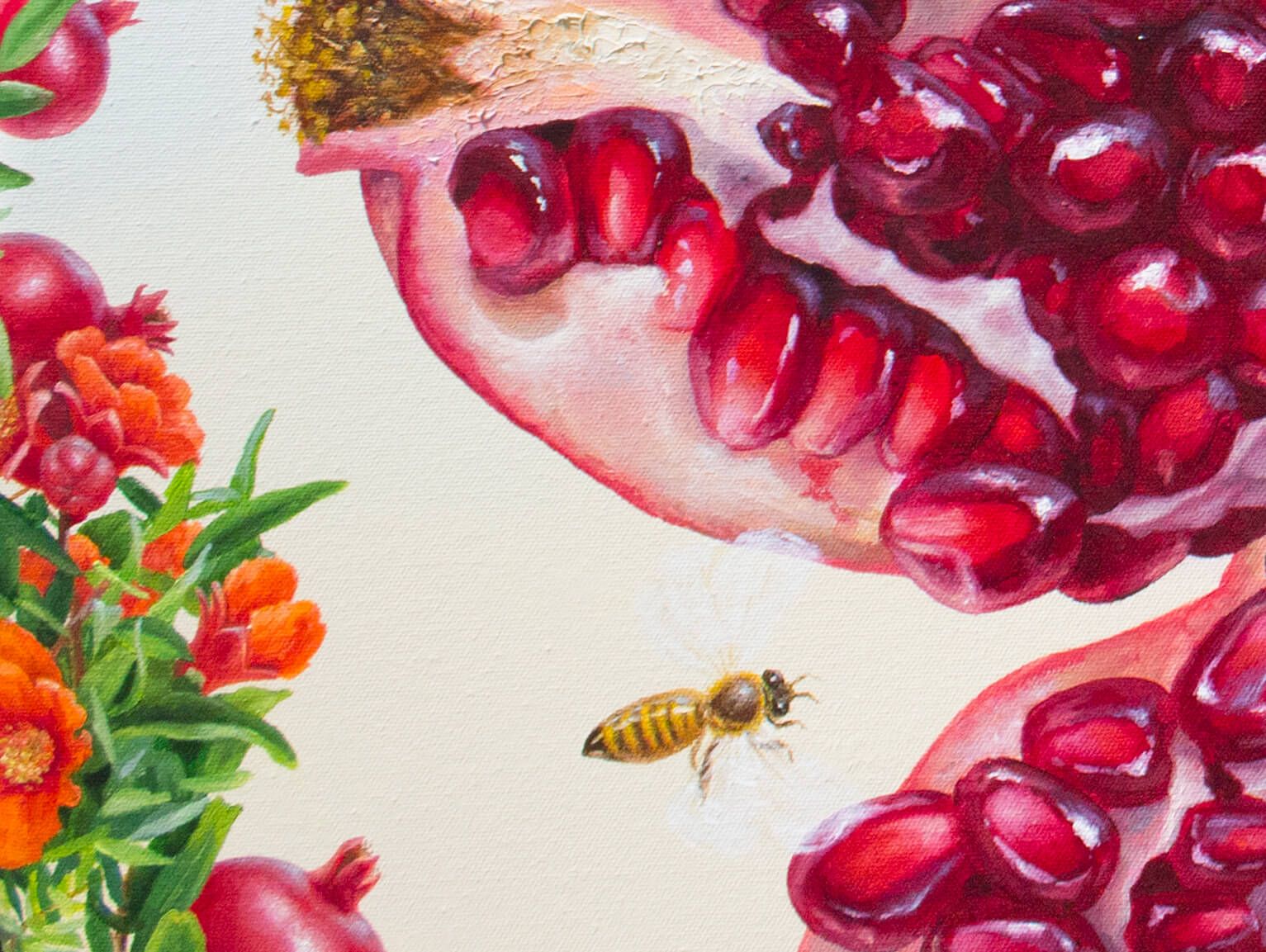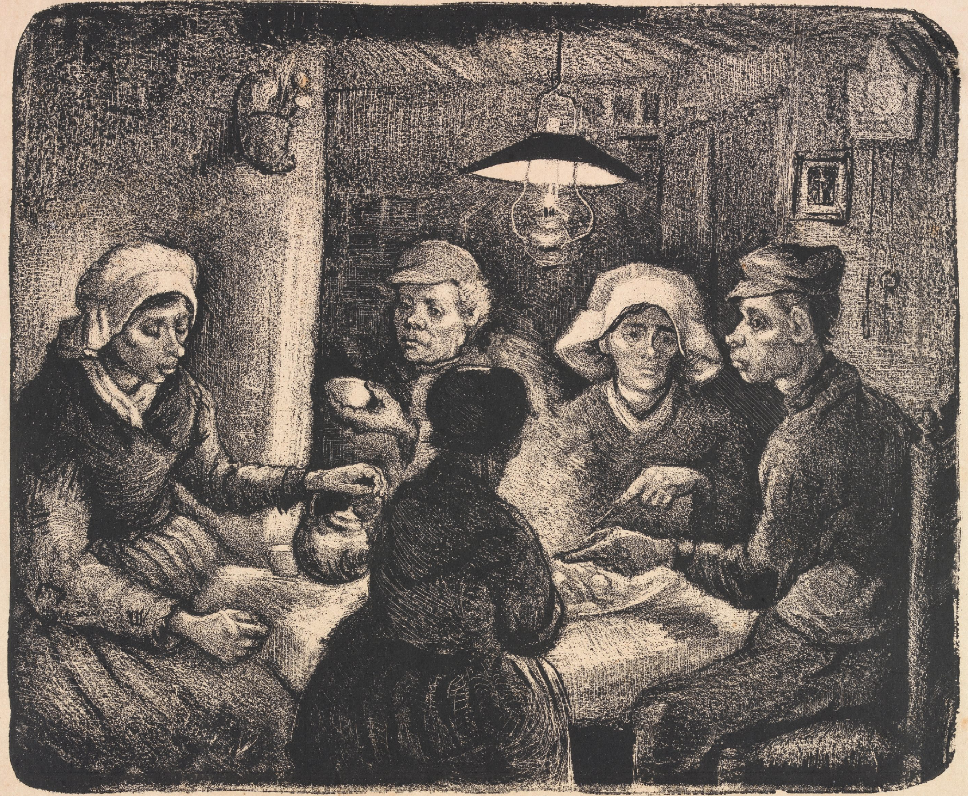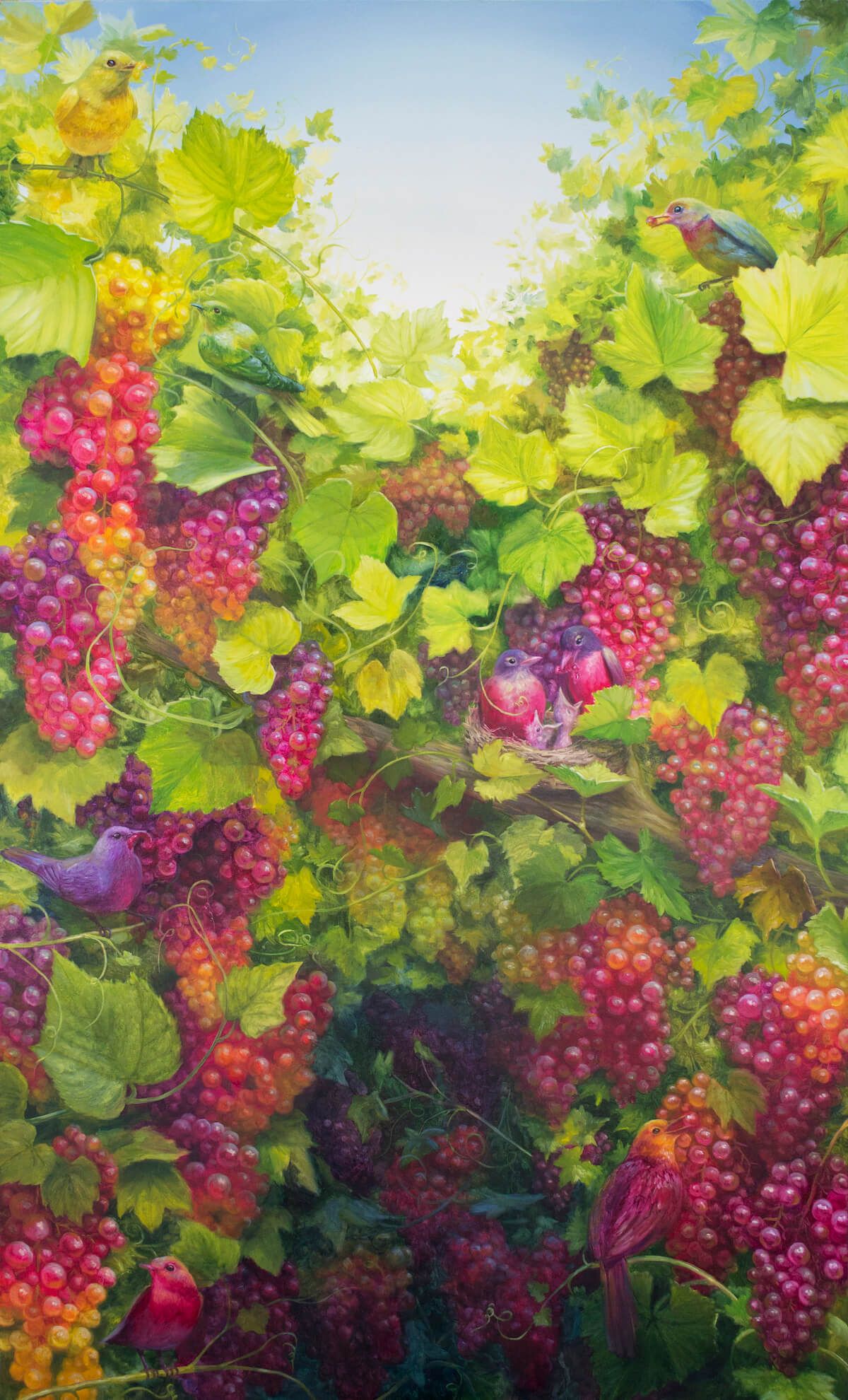Home through the eyes of Maysaloun Faraj
HOME 34, Acrylic on paper 25x18.5cm 29 April 2020. Courtesy of the artist.
From the Tigris River to London’s Thames, Maysaloun Faraj has created art that doesn’t know boundaries. Instead, it tells stories that inspire reflection and form connections that transcend differences. The London-based artist was born in the US to Iraqi parents and graduated with a BSc in Architecture from Baghdad University, then moved to London to create some of the most extraordinary works in recent decades. She received widespread critical praise in the art world, with over 35 exhibitions in more than 10 countries. Her art is also part of many public collections in some of the famous museums such as,the iconic British Museum, the National Museum For Women In The Arts, and Wereldmuseum, just to name a few.
During the pandemic and in the middle of lockdown, she began a new journey with her “HOME” series that resulted from a direct observation of her London home. She had to shift from her usual abstract style to still life paintings depicting details from her home with acrylic paint on small scale paper, allowing her to create a visual diary of this challenging time and share it with the world through her “HOME” series solo exhibition at Mark Hachem Gallery in Paris, and a special limited-edition publication named HOME: Lockdown 2020-22.
In this special interview, we get to speak with Maysaloun about her artistic practice and ideas, the importance of art, heritage, connection, isolation in the lockdowns, and healing traumas.
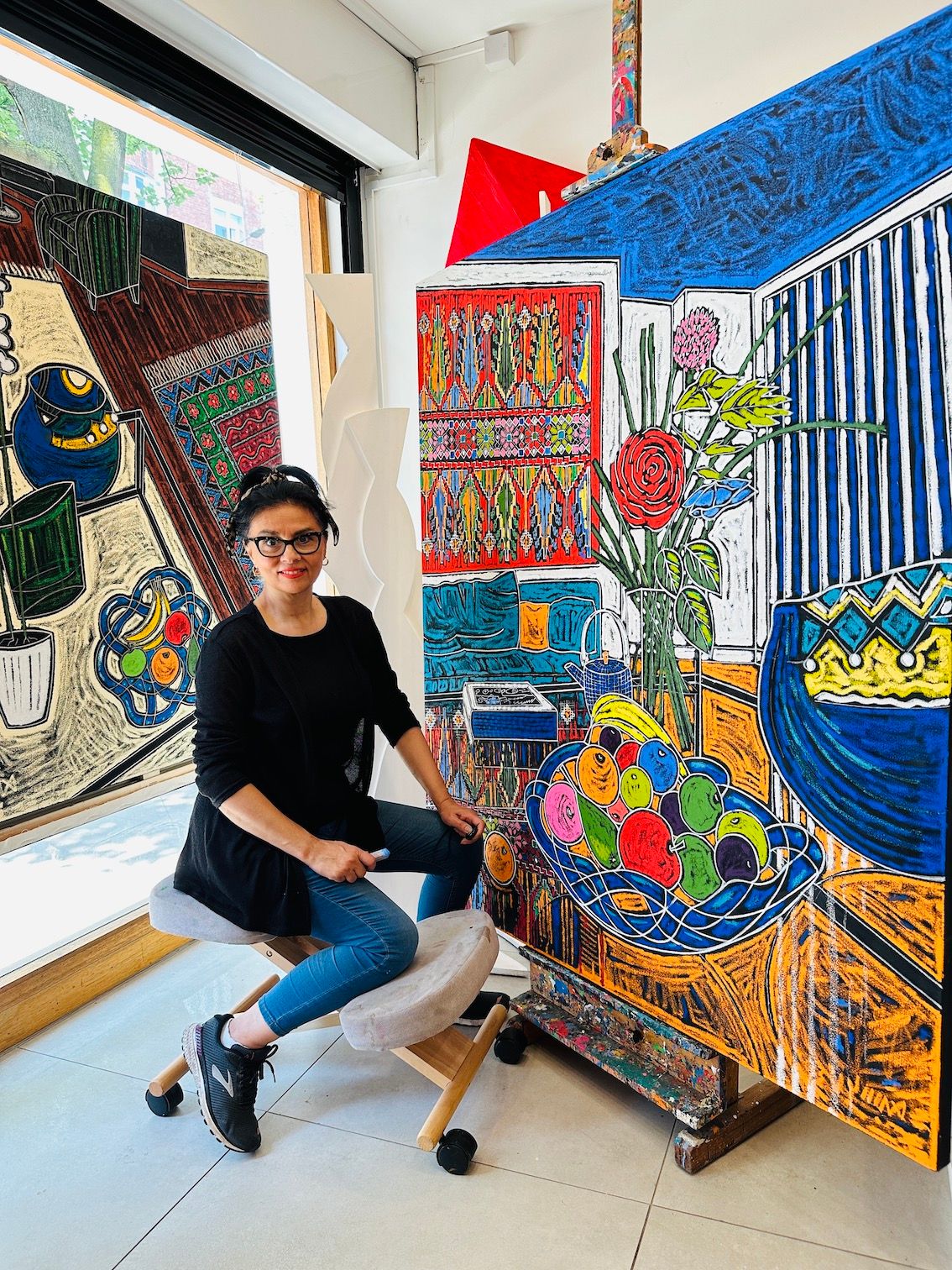
Maysaloun Faraj at her studio with In My Home Are Many Homes. London 2023. Courtesy of the artist.
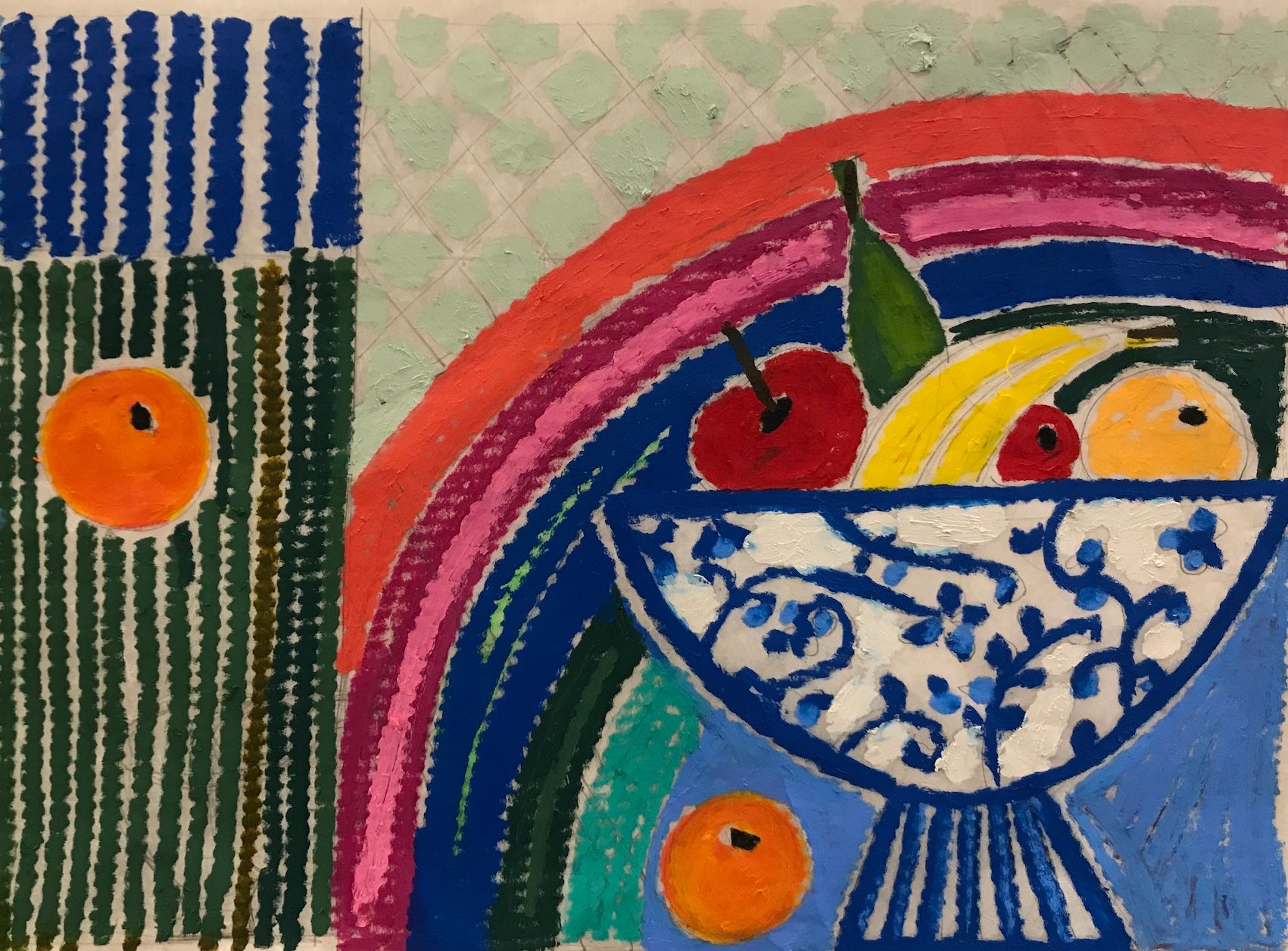
Farewell Dear Laila Shawa. Oil on paper 50x50cm 2022. Courtesy of the artist.
My connection to the Arabic language goes back a long way and has been instrumental in shaping my creative output throughout my career. It informs my cultural perspective, provides a rich tapestry of references, and inspires thought-provoking narratives that reflect on my artistic vision. Arabic is a rich expressive language, known for its poetic qualities.
Touching on this subject, the following is an extract from a talk I gave at the British Museum in 2006 to coincide with the acclaimed Word into Art exhibition, of which I was a participant (curated by Dr Venetia Porter):
“My love and need for art was reinforced on my return to Baghdad from the USA at the age of 13. Thanks to my mother I understood and spoke Arabic, to a certain degree. However, I had to ‘properly’ learn the language and found my first year at High School somewhat of a struggle. Nussous Edebia / Arabic Literature / Prose and Poetry was one subject I found particularly daunting. Not only were we meant to understand and analyse sophisticated and highly complex poetry of the different eras, spanning Pre-Islam’s Shu’ara al-Jahiliya to contemporary, moreover, we had to memorise each poem off by heart! Whilst it was natural and dare I say easy for most of my fellow students, for me, it was almost impossible, had it not been for art. Each poem I illustrated as a visual narrative alongside the book margins. It was the illustrations that I recounted when I recited the poem out loud in front of the class; a required practice in this subject. My books were covered inside out with ‘meaningful’ drawings. With this, I quickly learnt Arabic and sailed through the rest of my education. It was not until later however that I truly appreciated the value of what we underwent. Had we not been driven to memorise poetry in that way, I may still today, not know any “ín” my heart…and what a loss that would have been.”
My exposure to Arabic literature from an early age has provided me a well of inspiration, with layers of depth and resonance in my work. This has contributed to the way in which I have tackled complex themes, such as war, injustice and beauty lost, albeit subtly, shedding light on pressing issues that provoke thoughtful discussions.
I did not have access to my studio due to the Covid pandemic and its subsequent lockdowns. I resorted to making practical art within the means available: small works on paper. The nationwide message to ‘Stay Home Save Lives’, prompted me on a mission: to draw what I was facing, day in, day out, my living space, my HOME!
Never in my wildest dreams did I imagine the impact this pandemic would have on my art direction, affecting a huge shift in the way I paint in terms of subject, style, technique, size and medium. Prior to this, my residencies at the Cité Internationale des Arts in Paris instigated a series of large geometric abstract paintings. It was time in confinement however, that would trigger a series of small drawings featuring intimate perspectives of our living space and the objects within.
The last time I depicted the world subjectively was back in the mid-1970s as a student of architecture at Baghdad University. We would often go beyond the confines of the classroom in a quest to draw the traditional Baghdadi houses that aligned the banks of the river Tigris, and the narrow alleyways of the ancient city. In this process, I found myself reflecting deeply on the notion of ‘home’ and its broader implications.
In between lockdowns, I was able to gain access to my studio. However, I continued to explore the theme of HOME, re-interpreting these timely drawings on a grander scale in a different medium, mainly ‘oil on canvas’ as opposed to ‘acrylic on paper’. I found immense pleasure, peace and solace in a time of great uncertainty. Despite the turmoil of the day, there has been an abundance of solidarity, humanity, joy and beauty across the globe, and earth, is for the first time, in peace. I feel more connected, not only with the present, but also with the past, reliving treasured memories of what was once my home in that golden city in the heart of the cradle of civilisation, Baghdad. There truly is ‘no place like home’ if we are fortunate enough to have a home. On reflection, I have come to realise that after forty years of living in this vibrant city, the HOME series is a visual declaration that I can finally call London... HOME, where Baghdad has always been my ‘home’.
Colour is my language of love. In painting I bond with colour to sing the sublime and the sorrow, tapping into a range of sensations, from despondency brought on by conflict and war, to defiance in the face of adversity, to sheer hope, humanity and joy! Colour is the reason I paint, though it is not colour with which I paint, it is with my humanity, my soul!
Cultural references can also be conveyed; the vibrancy of the traditional weaves of southern Iraq for instance, have inevitably found their way into my painting! Colours elicit specific emotional responses, whereby bright and saturated colours are often associated with joy, optimism, and vitality, evoking positive emotions and a sense of hope.
In my HOME series, I simply drew what was directly in my view, including fruits in a bowl, set out on what I later termed ‘The Magic Coffee Table That Never Knew How Magical It Was Until Lockdown’! On this table, which is central to our living space, are the core elements that kept me sane throughout the treacherous pandemic lockdowns! Interpretation of why these scenes, including fruits, captivated my attention and imagination, came later.
In painting, the symbolism of fruit can vary depending on the context and cultural references. Hence, it is subjective, though fruits can often symbolize themes such as abundance, fertility, temptation, pleasure etc. My depiction of fruit during this difficult time in world history, I attribute to the ‘transience of life’.
My identity as a London-based / American-born / Iraqi, has given me a distinct viewpoint in my personal life and artistic career. This duality of belonging to both an Iraqi heritage and a ‘western’ culture, brings a unique perspective to my work, which inevitably offers insights into the complexities of identity, displacement, and belonging.
Throughout my work, I have taken on the responsibility of representing my culture and amplifying the voices of those who may not have had the same opportunities, shedding light on the diverse aspects of Iraqi culture, through the lens of one living both inside and outside of the motherland, challenging stereotypes and offering a more nuanced understanding of Iraq and its people. Besides my artwork, the project Strokes of Genius: Contemporary Iraqi Art is one prime example. To learn more about the project, please see www.incia.co.uk and www.ayagallery.co.uk.
I hope that my art can serve as a bridge between cultures, foster dialogue and promote a more nuanced and inclusive understanding of the richness, diversity, and complexity of Arab art, and through it the Arab world.
While my art is rooted in Arab identity, I seek to convey universal themes such as love, loss, joy, hope and resilience. By emphasising shared human experiences that transcend geographical boundaries, I hope to inspire empathy, understanding, and critical thinking among viewers, irrespective of cultural background.
Both my father, who was a Mechanical Engineer , and my mother, who studied ‘Home Economics’ which involved both Interior and Fashion Design, offered unwavering encouragement and support. They recognized and fostered my talent for art, developing my confidence and my ability to pursue my passion for art.
From an early age they introduced me to various forms of art, including visual, music, literature, and cultural experiences, which broadened my horizons and affected artistic growth. Despite my parent’s humble financial means, art materials were never in short supply; coloured pencils, paper and various craft material (including my mother’s wonderous sewing kit, with a phenomenal collection of all sorts of buttons!) was always at hand.
Besides mentorship and guidance, they exposed me to their own cultural heritage, traditions, and artistic influences, which rooted me deeply in Iraq and shaped my artistic identity and perspective.
The Orange. Oil on canvas 145x165cm. London 2022. Courtesy of the artist.
I hope that my art can serve as a bridge between cultures, foster dialogue and promote a more nuanced and inclusive understanding of the richness, diversity, and complexity of Arab art, and through it the Arab world.
While my art is rooted in Arab identity, I seek to convey universal themes such as love, loss, joy, hope and resilience. By emphasising shared human experiences that transcend geographical boundaries, I hope to inspire empathy, understanding, and critical thinking among viewers, irrespective of cultural background.
Both my father, who was a Mechanical Engineer , and my mother, who studied ‘Home Economics’ which involved both Interior and Fashion Design, offered unwavering encouragement and support. They recognized and fostered my talent for art, developing my confidence and my ability to pursue my passion for art.
From an early age they introduced me to various forms of art, including visual, music, literature, and cultural experiences, which broadened my horizons and affected artistic growth. Despite my parent’s humble financial means, art materials were never in short supply; coloured pencils, paper and various craft material (including my mother’s wonderous sewing kit, with a phenomenal collection of all sorts of buttons!) was always at hand.
Besides mentorship and guidance, they exposed me to their own cultural heritage, traditions, and artistic influences, which rooted me deeply in Iraq and shaped my artistic identity and perspective.
Art has long been recognized as a powerful tool for initiating and driving political change. Artists have historically used their creative expressions to protest, challenge societal norms, raise awareness, and advocate for various causes.
Art can evoke emotional responses and engage viewers, sparking conversations and encouraging reflection. By presenting alternative perspectives, exposing inequalities, or shedding light on hidden truths, artists can challenge the status quo and inspire critical thinking.
Art can serve as a platform for questioning authority, advocating for marginalized communities, and challenging oppressive ideologies. It has the potential to mobilize public opinion and catalyze collective action.
Through art, one can preserve and represent historical moments, ensuring that the struggles, voices, and stories of the marginalized are not forgotten.
It's important to recognize that while art can be a powerful catalyst for change, it often operates within a broader ecosystem of social and political activism, where collective efforts are required to bring about lasting transformation.
Tomorrow My Heart Will Heal. Earthstone, velvet and acrylic. 30x19x10cm. 2008. Private collection London. Part of the artist solo-exhibition Beats and Burdens Dreams 2009. Inaugurated by Dr Venetia Porter, this presentation was a tribute to Iraq’s heroic women, in response to the war in Iraq, her land and her people.
Art has the potential to contribute to the healing process of individuals and communities, as well as facilitate the reconciliation of past wounds. Art provides a medium for individuals to express and process their emotions, including pain, trauma, and grief. Through artistic creation, people can find a cathartic release, allowing them to explore and communicate their experiences in a non-verbal and symbolic manner. Art can help individuals confront and navigate complex emotions associated with the past, leading to personal healing. Art also has the power to bring people together and create a sense of shared experience, fostering dialogue, empathy, and understanding. Through visual storytelling and symbolic representation, artists can reinterpret and reimagine historical narratives, giving voice to marginalized perspectives and contributing to a more inclusive understanding of the past.
While art alone may not completely heal the wounds of the past, it can contribute to the healing process, encourage dialogue, and inspire individuals and communities to imagine and strive for a more hopeful future. Art has the potential to transcend barriers, spark empathy, and promote healing, making it a powerful tool for transformation and reconciliation.
Ever since I can remember, I revelled in making things and was fascinated with colour and form. So first and foremost, I would say inspiration is innate: from God! With this, I also draw inspiration from external experiences and diverse sources. This includes both personal experiences of growing up with an East/West cultural heritage, identity, belonging, memories, significant events, relationships, and life’s roller coaster journey, to world affairs; social and political, conflict, injustice, human rights, human wrongs, and beauty lost.
My mother, my father and my husband have been instrumental in my outlook on life, values, responsibilities, and faith.
Besides colour, food is another language of love! Traditional Iraqi cuisine holds a special place in my heart as it is often associated with nostalgic memories of home, family, and cultural traditions.
On the edge (Home 44), Oil on Canvas, 95X75cm, Novermber 2021. Courtesy of the artist.
